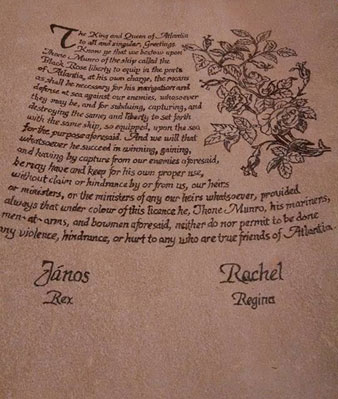Letter of Marque
Lord Ihone Munro, AS XL
Project Completed January, 2016
 In its simplest explanation, a letter of marque granted a ship permission to hunt down enemies of a crown while sailing within their waters. The ship and its “master” or “captain” would essentially be given the right to open fire upon foreign vessels to the manner in which they saw fit (in order to sink or capture the other vessel) without repercussion from the signing crown. In this way, the navy would be supplimented by the singular vessels (generally merchants) without having to supply the independent ships with supplies or pay. In return for this privelege, the ship also entered into accord that they would not fire upon ships of the crown that they had been granted these rights, or at their enemies.
In its simplest explanation, a letter of marque granted a ship permission to hunt down enemies of a crown while sailing within their waters. The ship and its “master” or “captain” would essentially be given the right to open fire upon foreign vessels to the manner in which they saw fit (in order to sink or capture the other vessel) without repercussion from the signing crown. In this way, the navy would be supplimented by the singular vessels (generally merchants) without having to supply the independent ships with supplies or pay. In return for this privelege, the ship also entered into accord that they would not fire upon ships of the crown that they had been granted these rights, or at their enemies.
Many sailors in period (Sir John Hawkins; 1550’s, Sir Francis Drake; 1560’s-1590’s) and after (Edward Teach;1710’s, Sir Henry Morgan; 1660’s) were initially granted a letter of marque while participating in legitimate activities. This life as a “privateer” or “corsair” would later turn into a life of illegal activities during the golden age of piracy, post period.
The letter itself is originally inspired by a letter of marque issued by Henry IV in 1405 to the captains John Wellys and Philip Taillour, both setting port in Bristol. This particular letter of marque was the foundation for the drafting of the guild charter of the Corsairium. When the guild was being signed into being at Ymir in 2005, the founding captains had opportunity to have their letters signed at the same time as the guild charter. This particular draft was the verbiage utilized by myself for The Black Rose. While the original charter was signed in paper (and lost many years ago), I’ve reproduced it in leather here.
I chose to burn into leather in this case because I wanted to try and get some more practice in pyrography. Whereas Pliny does reference writing being done on leather, I believe that it was a direct reference to parchment – since the leather itself has hair and an inconsistent structure. There are existing examples of rolled leather with writing from the Egyptians pre-period, so I figured why not. In my mind (and putting the “Creative” back in the SCA), doing this format would potentially keep the ink from disappearing in poor weather on the seas.
Constructive feedback is both welcome and appreciated, please let me know if I missed some pertinent information or if there's somewhere I can improve.
As always, thanks for reading!
Ihone
Sources
- Lord Russell, The French Corsairs
- Upton's Maritime Warfare and Prize
- Modar University (ref John Wellys and Philip Taillour LoM) - http://www.modaruniversity.org/LOM.htm
